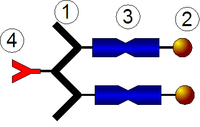
Photo from wikipedia
Abstract A commercial lipase from Candida cylindracea was modified with dextran by conjugating the e-amines in lysine residues with carbonyl groups to make the microenvironment around the lipase more hydrophilic… Click to show full abstract
Abstract A commercial lipase from Candida cylindracea was modified with dextran by conjugating the e-amines in lysine residues with carbonyl groups to make the microenvironment around the lipase more hydrophilic in the presence of organic solvents. The stabilities of the modified lipases in the presence of organic solvents were compared with that of the unmodified lipase. The maximum degree of modification, amount of dextran, and stability in the presence of ethanol and 2-propanol were obtained when the lipase was modified at pH 8.0, whereas the maximum specific activity was observed when the lipase was modified at pH 7.7. After modification with dextran at pH 8.0, the lipase showed higher stability in the presence of 25% (v/v) dimethyl sulfoxide (DMSO), ethanol, 2-propanol, toluene, and isooctane. Chemical modification with a polysaccharide such as dextran could be a promising approach for improving the organic solvent stability of enzymes.
Journal Title: Biochemical Engineering Journal
Year Published: 2019
Link to full text (if available)
Share on Social Media: Sign Up to like & get
recommendations!